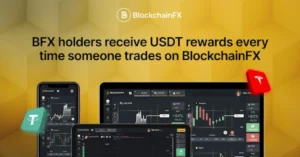BlockchainFX’s Positioning and Technological Innovation
Launched in March 2025, BlockchainFX initiated the presale of its core token BFX with the goal of becoming the first integrated trading platform for cryptocurrencies, stocks, forex, ETFs, commodities, and bonds. This model aims to address the pain points of traditional financial markets—fragmented asset classes and high trading costs—by enabling seamless multi-asset trading through blockchain technology. Its technical architecture is built on a dual-chain system using Ethereum and Polkadot, compatible with both ERC-20 and Substrate standards, allowing users to trade on-chain Tesla stock tokens (e.g., AAPL, TSLA) or exchange BTC for gold ETFs.
Currently, the BlockchainFX testnet is live, with simulated trading volumes exceeding USD 1 billion per day, reflecting strong market expectations for integrated multi-asset trading. Its core advantages include a low fee of 0.05% (only one-fifth of traditional brokerage fees) and privacy protection via zero-knowledge proofs, enabling users to trade compliant assets anonymously while meeting regulatory requirements.

Token Economics and Market Momentum
The BFX token is the central governance and utility token of the BlockchainFX ecosystem, with a total supply of 1 billion tokens. Holders of 35 BFX tokens enjoy benefits such as fee discounts, participation in platform governance, and staking rewards with annual yields between 8% and 15%.
In terms of market momentum, the BFX presale raised over USD 20 million in its first week, attracting institutional investors including Pantera Capital and Goldman Sachs’ digital asset division. The project has also secured data integration agreements with Nasdaq and the London Stock Exchange to support real-time trading of blue-chip tokenized assets. However, the high presale token allocation (35%) has raised concerns over potential sell-offs—if early investors liquidate their holdings, short-term price volatility could ensue.
Potential Impact: Fusion of Traditional Finance and Crypto Markets
If successfully implemented, BlockchainFX could accelerate the trend of bringing traditional assets on-chain. For example, users could collateralize tokenized Apple stocks to borrow USDC, or seamlessly reallocate portfolios between gold ETFs and Bitcoin. This cross-asset liquidity integration poses a direct challenge to traditional trading platforms such as Robinhood and eToro.
Regulatory compliance is another key aspect. BlockchainFX adopts a “regulatory sandbox” strategy: complying with the EU’s MiCA regulations and applying for an ATS license in the U.S. to trade security tokens legally. If approved, it will become the first compliant on-chain multi-asset trading platform. However, the SEC’s stringent scrutiny of security tokens (e.g., the XRP lawsuit) remains a potential barrier, and sudden policy shifts could limit its operational scope.
Risk Factors: Technology, Regulation, and Market Competition
Despite its promising outlook, BlockchainFX faces several risks:
- Technical Complexity: Cross-chain asset settlement involves handling interactions among multiple protocols, and smart contract vulnerabilities could lead to settlement errors (referencing the 2024 Solana outage).
- Regulatory Uncertainty: The SEC’s stance on security tokens could impact the legality of stock token trading.
- Market Competition: Competitors such as FTX 2.0 and Coinbase Derivatives are also entering the multi-asset trading space, so BlockchainFX must establish advantages in liquidity depth and user experience.
Future Outlook: Key Milestones for 2025
BlockchainFX’s roadmap shows plans to launch its mainnet in Q3 2025 with integration of real-time Nasdaq data streams, and in Q4, it aims to list on exchanges such as Huobi, Binance, and JuCoin. If its technology stability and regulatory compliance are validated, the project could bridge traditional finance and the crypto market, enhancing global capital flow efficiency.
For investors, BFX represents a high-yield opportunity but also entails risks associated with the complexity of multi-asset integration. It is advisable to monitor large holder movements using on-chain tools and pay attention to user growth and trading volume data on the Q2 testnet to assess the true value of the ecosystem. In the wave of financial innovation, rationally evaluating technological implementation capabilities and policy risks will be key to informed investment decisions.




